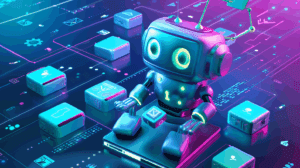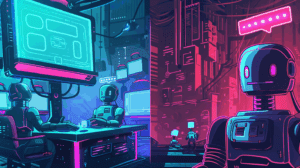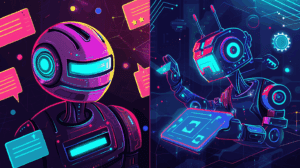Introduction to CrewAI 1.2
This introduction to CrewAI 1.2 highlights its role in representing a significant leap in multi-agent orchestration, blending advanced AI capabilities with streamlined user experience. This platform emphasizes the integration of intelligent automation to enhance operational efficiency and decision-making processes. By leveraging interconnected agents, CrewAI 1.2 enables organizations to automate complex workflows, drastically reducing the time spent on manual tasks.
One of the standout features of CrewAI 1.2 is its enhanced collaborative abilities, allowing multiple AI agents to work symbiotically. This ensures that information flows seamlessly between agents, producing smarter, context-aware responses that are beneficial across various business functions such as customer service, HR, and financial operations. The significance of this lies in the trend of businesses increasingly turning to AI agents as vital tools for improving productivity and responsiveness [Source: Mashable].
Moreover, the introduction of CrewAI 1.2 aligns with a broader movement towards autonomous decision-making—a critical component in today’s rapidly evolving technological landscape. With the advent of platforms like this, businesses can expect operational efficiencies along with enhanced strategic insight driven by data intelligence [Source: Robotics and Automation News].
In summary, CrewAI 1.2 is positioned at the forefront of the agentic AI revolution, driving innovation and transforming how organizations harness technology to solve complex challenges. For those interested in exploring the fundamentals and advancements of agentic AI further, resources like our articles on what is Agentic AI and real tasks handled by AI agents provide valuable insights.
Understanding Multi-Agent Orchestration
Multi-agent orchestration is a transformative approach that enhances the operational capacity of multi-agent systems. At its core, this concept involves coordinating multiple autonomous agents to work in concert, improving efficiency and responsiveness to dynamic environments. The orchestration mechanism ensures that each agent interacts seamlessly with others and aligns its actions towards common objectives.
For instance, in the context of banking, agentic systems are designed to collect and process real-time data from diverse sources, enabling financial institutions to respond swiftly to market changes and customer needs. This orchestration facilitates the delivery of consistent and contextually relevant information, thereby enhancing decision-making processes across departments [Source: Fintech Futures].
Moreover, the orchestration of AI agents is increasingly vital within enterprises, where tools powered by artificial intelligence, such as IBM’s integrations, can automate a variety of tasks from security compliance to operational efficiencies [Source: CSO Online]. This capability is crucial in the modern landscape, where organizations are striving to minimize workloads while maximizing productivity through intelligent automation. With the right orchestration, multi-agent systems can provide significant advantages, making it essential for organizations to explore these systems further [Source: Mashable].
For more insights on AI agents and their capabilities, you might find our articles on real-world applications of AI agents and the differences between chatbots and smart agents particularly useful.
Key Features of CrewAI 1.2
CrewAI 1.2 introduces several key features aimed at enhancing agent interaction and coordination.
1. **Centralized Real-Time Interaction**: Building on the ability to visualize automation, CrewAI 1.2 equips users with a centralized interface that allows real-time monitoring and management of agents. This feature enhances transparency and gives teams clarity on how different agents interact, facilitating quicker, informed decisions [Source: Robotics and Automation News].
2. **Improved Agent Collaboration**: The update strengthens the capabilities for agents to work collaboratively, simulating an environment where both virtual and physical agents can seamlessly interact. This allows for more sophisticated task management and enhances overall operational efficiency, particularly in automated environments [Source: Robotics and Automation News].
3. **Enhanced Customer Interaction**: With improved AI capabilities, CrewAI 1.2 leads to more personalized customer engagement. By utilizing advanced algorithms, it can tailor interactions based on user behavior and preferences, ensuring that every customer touchpoint is efficient and relevant [Source: Forbes].
These features collectively position CrewAI 1.2 as a robust tool for businesses looking to enhance their operational synergy through sophisticated agent coordination. For more insights on the transformative role of AI in decision-making and interaction, explore our articles on Agentic AI and AI agents’ efficiency.
Setting Up CrewAI 1.2
Step 1: System Requirements
Before installing CrewAI 1.2, ensure that your system meets the following minimum requirements:
– **Operating System**: Windows 10 or above, macOS Mojave or above, or a modern Linux distribution.
– **Processor**: Dual-core CPU, 2 GHz or faster.
– **RAM**: Minimum of 8 GB.
– **Storage**: At least 500 MB of free disk space available.
Step 2: Download CrewAI 1.2
Visit the official CrewAI website to download the latest version of CrewAI 1.2. Ensure you select the correct package for your operating system.
Step 3: Installation Process
1. **Windows**:
– Double-click the downloaded `.exe` file and follow the on-screen instructions.
– Make sure to allow installation permissions if prompted.
2. **macOS**:
– Open the `.dmg` file and drag the CrewAI icon to the Applications folder.
– Launch CrewAI from the Applications directory.
3. **Linux**:
– Extract the downloaded tarball using `tar -xvzf crewai-1.2.tar.gz`.
– Navigate to the extracted directory and run `sudo ./install.sh` from the terminal.
Step 4: Initial Configuration
After installation, launch CrewAI 1.2:
– Follow the setup wizard to configure initial settings like user preferences, data management options, and integrations.
– Connect CrewAI to your existing databases and APIs as required.
Step 5: Optimize Performance
To ensure optimal performance from CrewAI:
– Regularly update the software to the latest version for security and feature improvements.
– Monitor your system resources to ensure CrewAI is not overloading your machine.
– Review the integration configurations periodically to align with your operational needs [Source: TechXplore].
Step 6: Troubleshooting Issues
If you encounter issues during installation or setup:
– Refer to the FAQ section in the CrewAI help documentation.
– Reach out to the support team via the official website for immediate assistance.
Step 7: Best Practices
– Regularly back up your configuration settings to prevent data loss.
– Schedule routine maintenance checks to diagnose performance issues proactively.
By following these detailed steps, you’ll ensure a smooth installation and an efficient configuration of CrewAI 1.2, empowering your AI-assisted operations right from the start. For more on optimizing AI agents, visit our guide on what can AI agents actually do.
Building Your First Multi-Agent System
To create your first multi-agent system using CrewAI 1.2, follow these step-by-step instructions while avoiding common pitfalls.
1. **Setting Up Environment**: Start by ensuring your development environment is ready. Install CrewAI 1.2 and any necessary dependencies. Refer to this guide for installation tips specific to new users.
2. **Defining Agents**: Clearly define the purpose and parameters of the agents you want to create. Naming specific functions and tasks each agent will handle can help streamline development. For example, you might designate one agent for customer service inquiries and another for data analysis.
3. **Integration with Other Systems**: Integrating CrewAI with existing platforms or APIs can enhance functionality. Be mindful of compatibility issues. Utilizing the API documentation extensively can prevent integration errors. More insight can be found in Goodbye Chatbots, Hello Smart Agents.
4. **Testing and Debugging**: Utilize CrewAI’s built-in debugging features extensively. Conduct rigorous testing by running simulations before deploying your agents. This step is crucial to catch potential errors in logic or integration.
5. **Avoiding Common Pitfalls**: Some typical mistakes include failing to outline clear communication protocols between agents, neglecting to test for scalability, and underestimating maintenance. Always consider the long-term management of your agents—this could save significant time and resources later [Source: Mashable].
6. **Iterative Development**: Build your system iteratively. Start small, develop a single agent, and gradually integrate more complexity. Regularly solicit feedback during this process to make necessary adjustments early on.
7. **Documentation and Support**: Keep thorough documentation of your development process and seek help from online communities or forums for advice and tips. Crews working collaboratively tend to build more robust systems.
8. **Continuous Learning**: Stay updated on best practices for AI and automation by following relevant blogs and articles found on resources like Agentic AI.
Starting with these tips will guide you in building an efficient and reliable multi-agent system using CrewAI 1.2. Keep the modular design in mind, allowing for functionality and scalability as your project’s needs evolve.
Advanced Orchestration Techniques
Advanced orchestration techniques in multi-agent systems rely on a variety of sophisticated strategies aimed at enhancing agent interactions and optimizing task allocations. These techniques facilitate seamless communication between agents, enabling them to collaboratively solve complex problems and manage workloads more efficiently.
One pivotal approach is the implementation of a centralized coordination model, where a master agent oversees the actions of subordinate agents, ensuring that tasks are assigned based on their capabilities and current workloads. This model enables real-time adjustments to allocations, significantly reducing bottlenecks and improving overall system responsiveness. Studies have shown that effective central coordination leads to a notable decrease in task execution time and increases in agent efficiency [Source: Mashable].
Additionally, decentralized orchestration methods are gaining traction, whereby agents operate autonomously while using peer-to-peer communication to dynamically share task information. This distributed approach empowers agents to quickly adapt to changes in their environment, foster collaborative problem-solving, and enhance robustness against single points of failure. Research indicates that decentralized systems can lead to increased resilience and flexibility, which are crucial for handling unpredictable workloads [Source: Nature].
Another advanced technique is the use of machine learning algorithms to predict agent performance and optimize task assignments proactively. By analyzing historical performance data, these algorithms can suggest which agents are best suited for specific tasks, thereby improving efficiency and outcome quality. The integration of AI-driven predictive analytics into orchestration strategies is becoming increasingly essential for organizations aiming to maintain competitive advantage in dynamic environments.
Moreover, implementing robust communication protocols is critical in enhancing the interaction quality between agents. Well-defined messaging standards and feedback loops ensure that agents not only share status updates but also learn from each interaction, fostering continuous improvement over time. This mutually beneficial exchange aligns with the principles of self-organization in multi-agent systems, where agents autonomously adjust their behaviors based on collective input [Source: AgentMode AI].
In summary, adopting these advanced orchestration techniques allows organizations to leverage multi-agent systems more effectively, resulting in improved efficiency, enhanced task management, and greater adaptability to changing demands.
Best Practices for Performance Optimization
To enhance the efficiency of multi-agent systems using CrewAI 1.2, consider the following proven methods:
1. **Tailored Agent Configuration**: Customize AI agents to align with specific personality types and work styles. Research from MIT highlights that tailored AI agents can improve productivity significantly—up to 60% in certain scenarios—by minimizing superfluous social interactions among team members while maintaining output quality [Source: Bloomberg Law].
2. **Data Optimization through Industry Clouds**: Leverage industry-specific clouds to streamline data management and ensure compliance with applicable regulations. This approach facilitates quicker data ingestion and system alignment with best practices, which can enhance the operational speed and reliability of multi-agent systems [Source: Forbes].
3. **Continuous Training and Validation**: Implement regular updates and validation benchmarks for AI agents. Utilizing real-world data to continuously test and improve agent performance helps ensure they meet required standards, enhancing effectiveness in tasks such as clinical data abstraction [Source: HIT Consultant].
4. **Integration with Existing Workflows**: Seamlessly integrate multi-agent systems into existing workflows to minimize disruption and maximize utility. Consider methodologies that enhance collaboration among human team members and AI agents, striking a balance between automation and interpersonal communication.
5. **Regular Performance Evaluation**: Establish metrics for evaluating the performance of each agent. Frequent assessments allow for adjustments based on evolving needs and can help in refining operational protocols for better overall system performance.
By applying these best practices, organizations can significantly optimize the performance of their multi-agent systems, driving efficiency and enhancing outcomes in various applications.
Use Cases and Real-World Applications
CrewAI 1.2 exemplifies the transformative potential of multi-agent orchestration across various industries, enhancing productivity, efficiency, and scalability. Here are key applications that illustrate its versatility:
1. **Manufacturing Industry**: The integration of CrewAI in manufacturing is leading to a new era characterized by AI-human collaboration. With tools that enhance skills training and elevate job functions, CrewAI can significantly optimize production processes, making environments more conducive to attracting younger talent. This symbiotic relationship is poised to redefine how operational issues are resolved on the frontlines, essentially creating a “superagency” that merges AI capabilities with human insight [Source: The Manufacturer].
2. **E-commerce Automation**: CrewAI effectively supports e-commerce platforms by automating tasks usually handled by human labor, such as image editing and site customization. By streamlining these processes, businesses can manage larger inventories and higher transaction volumes without a corresponding increase in overhead, thus ensuring a seamless customer experience [Source: Forbes].
3. **Customer Service Enhancement**: The deployment of CrewAI within customer service chains has shown to reduce response times and enhance service quality. Companies using multi-agent systems report significantly lowered operational costs while maintaining high service levels. AI agents can manage inquiries efficiently and provide personalized assistance, which boosts overall customer satisfaction [Source: Mashable].
4. **Business Automation for Efficiency**: CrewAI serves as a backbone for automating various business functions, including financial reconciliation and HR support. This automation allows for operational tasks to be managed with greater accuracy and speed, freeing up human resources for more complex and creative responsibilities, thus enhancing overall productivity [Source: Robotics and Automation News].
Each of these applications showcases how CrewAI 1.2 not only streamlines operations within specific sectors but also contributes to a broader trend of embracing AI-driven efficiency and automation, heralding a new age in various industries.
Troubleshooting Common Issues
When working with CrewAI 1.2 in multi-agent systems, users may encounter various common issues. Here’s a guide to tackling some of these challenges:
1. **Agent Misalignment**: Misalignment occurs when agents behave in ways that do not align with user intentions or broader system goals. This can result from insufficient training data or improper goal setting. To resolve this, ensure that the agents are appropriately configured with clear objectives and ample training on desired behaviors. For more insights on why this happens, see the discussion on agentic misalignment.
2. **Performance Bottlenecks**: Users might notice slow responses or delays in processing. This can stem from network issues or overloading the agents beyond their designed capacity. To troubleshoot, assess system loads and ensure that your network infrastructure can handle the demands of simultaneous agent interactions. Additionally, consider optimizing tasks for efficiency. Learn more about performance improvements in AI agent tech stacks.
3. **Security Vulnerabilities**: As with any AI system, security is paramount. Agents are susceptible to cyber risks that can be introduced through data poisoning or unauthorized access. Implement robust security measures, such as access controls and regular audits of agent activities and data integrity. This proactive stance can mitigate potential threats, as detailed in general security recommendations for AI agents.
4. **Data Access Issues**: Agents may occasionally lose access to required data sources, hindering their decision-making capabilities. Make sure that all necessary data feeds are consistently available and that your connections are robust. Regularly monitor data flow and set up alerts for any disconnections.
5. **Integration Challenges**: Integration with existing systems can be complex, especially if legacy systems are involved. For seamless integration, focus on developing middleware solutions that can bridge the gaps between CrewAI 1.2 and other software. This strategy can simplify data sharing and communication across platforms.
By systematically addressing these common issues, users can enhance the functionality and reliability of CrewAI 1.2 in their multi-agent systems. For a deeper understanding of the choices and capabilities of AI agents, consider exploring key AI agent functionalities.
Conclusion and Future Directions
The rapid advancements in multi-agent orchestration technologies illustrate a promising future landscape. Key takeaways from recent developments emphasize the integration of innovative solutions like Make Grid, which enables users to visualize and manage AI components effectively. This consolidation enhances decision-making processes by improving performance insights and reducing operational complexities, allowing teams to scale more rapidly.
Moreover, the current trajectory reflects a growing trend toward intelligent systems that optimize processes such as transaction orchestration in payments. By employing sophisticated routing methods, businesses can achieve higher success rates while minimizing costs and customer frustrations—marks of a robust multi-agent framework.
Future directions in this field seem focused on creating environments where AI agents can operate securely. As articulated in a recent overview on AI agents, the integration of automated systems into various industries is accompanied by a necessity for enhanced cybersecurity measures. Organizations will need to implement robust security protocols to safeguard these autonomous agents against emerging cyber threats.
In the coming years, technologies that foster trust and safety in connected environments, as highlighted by the World Economic Forum, will likely take precedence. The evolution of multi-agent orchestration will continue to shape critical sectors, enabling more resilient infrastructures capable of addressing complex global challenges. This transformation not only signifies a shift in operational capacity but also illustrates potential benefits for societal needs as automated systems become ingrained in our daily interactions.
Sources
- AgentMode AI – Beginner’s Guide to n8n
- AgentMode AI – Goodbye Chatbots, Hello Smart Agents
- AgentMode AI – What Can AI Agents Actually Do?
- AgentMode AI – What is Agentic AI?
- HIT Consultant – AI for Clinical Data Abstraction
- Bloomberg Law – AI Agents Make Humans More Productive
- Forbes – Are Marketing Clouds Just Marketing?
- Forbes – How Online Businesses are Winning Customers
- Mashable – 7 AI Agents Widely Used by Companies Right Now
- Robotics and Automation News – Savant Labs Unveils Agentic Analytics Automation Suite
- Robotics and Automation News – Siemens Advances Autonomous Production
- Robotics and Automation News – World Economic Forum’s Top 10 Emerging Technologies
- Robotics and Automation News – Make Launches Software
- CSO Online – IBM Combines Governance and Security Tools
- Fintech Futures – Agentic Banking
- Technology Decisions – AI Agents Securing the Artificial Workforce
- Retail Touchpoints – Merchants are Losing Billions to Failed Payments
- MIT News – AI Agents Make Humans More Productive
- Nature – Research on Decentralized Systems
“`



